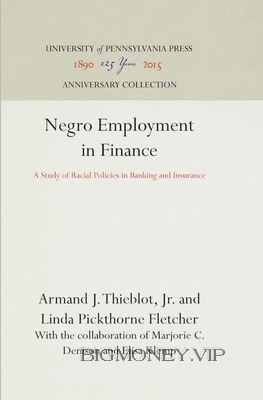
CHAPTER I.
Introduction
Although the banking industry is one of the mainstays of
the American economy and has always been a necessary partner
in new movements in technology and industrialization, it has
not been on the forefront of social change. Banking was among
the last of the country's major industries to abandon traditional
hiring practices and make available responsible job opportunities
to Negroes. Not until 1962 or 1963 did the industry begin a
noticeable program of hiring Negroes. But once begun, in at
least the largest of the nation's banking establishments, the pro-
gram has been pursued vigorously.
The reasons for banking's long delay are many. On the part
of banks themselves, inexperience with untrained job applicants
(of whom many are Negroes), fear of a loss of accounts or
other reaction from either customers or employees, and a mis-
placed conception of the prestige image of the industry all had
their effect. Many potentially qualified Negro job applicants
were undoubtedly deterred by the nature and image of the in-
dustry, its level of skills demanded for even entry-level jobs,
and its historical hiring patterns. There are many other factors.
The study is concerned with the evolution and present status
of Negro employment policies in the banking industry. Basic
to an understanding of the acceptance of Negroes by the in-
dustry is the nature and structure of the industry itself, which
is discussed in the next chapter.
CHAPTER II.
Structure of the American Banking Industry
The history of the American banking industry has been a
history of change, for the industry has always been closely as-
sociated with the changing requirements and demands of a
rapidly evolving economy. The product of the industry is credit,
and the demand for credit takes many forms. From the waning
years of the eighteenth century through the beginning of the
twentieth century America was expanding in all directions. Mer-
chants and traders, the westward moving farmers, the trans-
portation system which had to be built to tie the two together,
manufacturers, suppliers, and the general public all wanted cred-
it. And banks arose to fill the need.
By 1820, only forty years after the founding of the country's
first bank in Philadelphia, 300 banking institutions were in ac-
tive operation Twenty years later, there were over 1,000, and
by 1860, there were more than 2,000. The numerical peak of
30,900 commercial banks was reached in 1920.
For all its growth and spread in every finançai direction,
banking remained essentially an infant industry until the mid-
1930's. "On the whole, the banking system mirrored the so-
ciety as a whole—diverse, disorderly, growing rapidly but at an
uneven pace of fits, jerks, and starts—enterprising and pro-
gressive, but not always overly scrupulous." With relatively
easy entry into the industry over most of its history, and with
the lure of high profits from the endless credit needs of the
burgeoning country—and lacking the machinery to avoid em-
phasizing swings in the business cycle—the industry contributed
heavily to depressions and panics which seemed to come with
distressing frequency. Severe banking panics, actually attributa-
ble to a wide variety of causes but almost always associated
with a general distrust on the part of the American population
of its banking system, occurred in 1837, 1857, 1873, 1884, 1893,
1903, 1907, 1919, 1929, and 1933.




